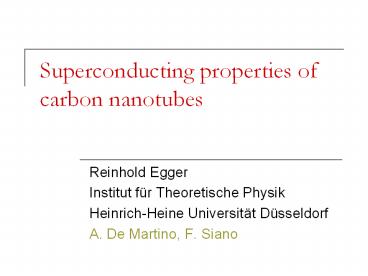Superconducting properties of carbon nanotubes - PowerPoint PPT Presentation
Title:
Superconducting properties of carbon nanotubes
Description:
Discrete Hubbard-Stratonovich transformation Ising field decouples Hubbard-U ... Stochastic sampling of Ising paths. Discretization error can be eliminated by ... – PowerPoint PPT presentation
Number of Views:182
Avg rating:3.0/5.0
Title: Superconducting properties of carbon nanotubes
1
Superconducting properties of carbon nanotubes
- Reinhold Egger
- Institut für Theoretische Physik
- Heinrich-Heine Universität Düsseldorf
- A. De Martino, F. Siano
2
Overview
- Superconductivity in ropes of nanotubes
- Attractive interactions via phonon exchange
- Effective low energy theory for superconductivity
- Quantum phase slips, finite resistance in the
superconducting state - Josephson current through a short nanotube
- Supercurrent through correlated quantum dot via
Quantum Monte Carlo simulations - Kondo physics versus p-junction, universality
3
Classification of carbon nanotubes
- Single-wall nanotubes (SWNTs)
- One wrapped graphite sheet
- Typical radius 1 nm, lengths up to several mm
- Ropes of SWNTs
- Triangular lattice of individual SWNTs
(typically up to a few 100) - Multi-wall nanotubes (MWNTs)
- Russian doll structure, several inner shells
- Outermost shell radius about 5 nm
4
Superconductivity in ropes of SWNTs Experimental
results
Kasumov et al., PRB 2003
5
Experimental results II
Kasumov et al., PRB 2003
6
Continuum elastic theory of a SWNT Acoustic
phonons
De Martino Egger, PRB 2003
- Displacement field
- Strain tensor
- Elastic energy density
Suzuura Ando, PRB 2002
7
Normal mode analysis
- Breathing mode
- Stretch mode
- Twist mode
8
Electron-phonon coupling
- Main contribution from deformation potential
- couples to electron density
- Other electron-phonon couplings small, but
potentially responsible for Peierls distortion - Effective electron-electron interaction generated
via phonon exchange (integrate out phonons)
9
SWNT as Luttinger liquid
Egger Gogolin Kane et al., PRL 1997 De Martino
Egger, PRB 2003
- Low-energy theory of SWNT Luttinger liquid
- Coulomb interaction
- Breathing-mode phonon exchange causes attractive
interaction - Wentzel-Bardeen singularity very thin SWNT
For (10,10) SWNT
10
Superconductivity in ropes
De Martino Egger, cond-mat/0308162
- Model
- Attractive electron-electron interaction within
each of the N metallic SWNTs - Arbitrary Josephson coupling matrix, keep only
singlet on-tube Cooper pair field - Single-particle hopping negligible
Maarouf, Kane Mele, PRB 2003
11
Order parameter for nanotube rope
superconductivity
- Hubbard Stratonovich transformation complex
order parameter field - to decouple Josephson terms
- Integration over Luttinger liquid fields gives
formally exact effective (Euclidean) action
12
Quantum Ginzburg Landau (QGL) theory
- 1D fluctuations suppress superconductivity
- Systematic cumulant gradient expansion
Expansion parameter - QGL action, coefficients from full model
13
Amplitude of the order parameter
- Mean-field transition at
- For lower T, amplitudes are finite, with gapped
fluctuations - Transverse fluctuations irrelevant for
- QGL accurate down to very low T
14
Low-energy theory Phase action
- Fix amplitude at mean-field value Low-energy
physics related to phase fluctuations - Rigidity
- from QGL, but also influenced by
dissipation or disorder
15
Quantum phase slips Kosterlitz-Thouless
transition to normal state
- Superconductivity can be destroyed by vortex
excitations Quantum phase slips (QPS) - Local destruction of superconducting order allows
phase to slip by 2p - QPS proliferate for
- True transition temperature
16
Resistance in superconducting state
- QPS-induced resistance
- Perturbative calculation, valid well below
transition
17
Comparison to experiment
- Resistance below transition allows detailed
comparison to Orsay experiments - Free parameters of the theory
- Interaction parameter, taken as
- Number N of metallic SWNTs, known from residual
resistance (contact resistance) - Josephson matrix (only largest eigenvalue
needed), known from transition temperature - Only one fit parameter remains
18
Comparison to experiment Sample R2
- Nice agreement
- Fit parameter near 1
- Rounding near transition is not described by
theory - Quantum phase slips ? low-temperature resistance
- Thinnest known superconductors
19
Comparison to experiment Sample R4
- Again good agreement, but more noise in
experimental data - Fit parameter now smaller than 1, dissipative
effects - Ropes of carbon nanotubes thus allow to observe
quantum phase slips
20
Josephson current through short tube
Buitelaar, Schönenberger et al., PRL 2002, 2003
- Short MWNT acts as (interacting) quantum dot
- Superconducting reservoirs Josephson current,
Andreev conductance, proximity effect ? - Tunable properties (backgate), study interplay
superconductivity ? dot correlations
21
Model
- Short MWNT at low T only a single
spin-degenerate dot level is relevant - Anderson model
- (symmetric)
- Free parameters
- Superconducting gap ?, phase difference across
dot F - Charging energy U, with gate voltage tuned to
single occupancy - Hybridization G between dot and BCS leads
22
Supercurrent through nanoscale dot
- How does correlated quantum dot affect the DC
Josephson current? - Non-magnetic dot Standard Josephson relation
- Magnetic dot - Perturbation theory in G gives
p-junction
Kulik, JETP 1965 - Interplay Kondo effect superconductivity?
- Universality? Does only ratio matter?
Kondo temperature
23
Quantum Monte Carlo approach Hirsch-Fye
algorithm for BCS leads
- Discretize imaginary time in stepsize
- Discrete Hubbard-Stratonovich transformation ?
Ising field decouples Hubbard-U - Effective coupling strength
- Trace out lead dot fermions ? self-energies
- Now stochastic sampling of Ising field
24
QMC approach
Siano Egger
- Stochastic sampling of Ising paths
- Discretization error can be eliminated by
extrapolation - Numerically exact results
- Check Perturbative results are reproduced
- Low temperature, close to T0 limit
- Computationally intensive
25
Transition to p junction
26
Kondo regime to p junction crossover
- Universality Instead of Anderson parameters,
everything controlled by ratio - Kondo regime has large Josephson current
Glazman Matveev, JETP 1989 - Crossover to p junction at surprisingly large
27
Conclusions
- Ropes of nanotubes exhibit intrinsic
superconductivity, thinnest superconducting wires
known - Low-temperature resistance allows to detect
quantum phase slips in a clear way - Josephson current through short nanotube
Interplay between Kondo effect,
superconductivity, and p junction






























